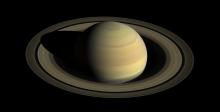Listen to today's episode of StarDate on the web the same day it airs in high-quality streaming audio without any extra ads or announcements. Choose a $8 one-month pass, or listen every day for a year for just $30.
You are here
Autumnal Equinox
Day and night will be just about equal the next few days — for the entire world. That’s because fall arrives in the northern hemisphere late tonight. It’s the September equinox — the moment the Sun crosses the equator from north to south.
At that moment, the Sun stands directly above the equator. So no matter where you are, the Sun rises due east and sets due west.
“Equinox” means “equal nights.” That tells us that day and night should be the same length. But that’s not quite the case. Daytime — the interval from sunrise to sunset — lasts a few minutes longer than nighttime. Here in the northern hemisphere, they won’t balance out until a few days after the equinox.
One reason for the difference is the way we figure the moments of sunrise and sunset. For the day and night to be equal, we’d have to think of them as the time the Sun is bisected by the equator — when half is in view, and half is below the horizon.
Instead, of course, we consider sunrise as the moment the top of the Sun first peeks into view. And sunset is the moment when the Sun fully disappears. That adds a minute or so to the “daytime” side of the equation.
And we don’t actually see the Sun rise and set — at least not live. Earth’s atmosphere bends the Sun’s rays around the planet. So by the time you see the setting Sun touch the western horizon, it’s actually already set. You’re seeing an extended version of things — stretching the daylight over a few extra minutes.
Script by Damond Benningfield





